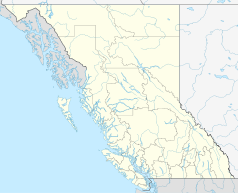Zeballos
| Zeballos | ||
|---|---|---|
 At the port of Zeballos |
||
| Location in British Columbia | ||
|
|
||
| State : |
|
|
| Province : | British Columbia | |
| Regional District : | Strathcona | |
| Coordinates : | 49 ° 59 ′ N , 126 ° 51 ′ W | |
| Area : | 1.56 km² | |
| Residents : | 125 (as of 2011) | |
| Population density : | 80.1 inhabitants / km² | |
| Time zone : | Pacific Time ( UTC − 8 ) | |
| Postal code : | V0P | |
| Foundation : | 1952 (incorporated) | |
Zeballos is a small, remote village on the west coast of Vancouver Island in the Canadian province of British Columbia .
location
Zeballos is located on a bay that opens to Esperanza Inlet , the inlet between Vancouver Island and Nootka Island . Immediately east of Zeballos is the 1875 m high Rugged Mountain. A road leading about 40 kilometers north connects the place with the main highway of the island ( Highway 19 ) from Port Hardy to Victoria . Zeballos is named after the discoverer Ciriaco Cevallo.
history
Zeballos is one of the many places in British Columbia whose name suggests Spanish roots. Ciriaco Cevallos was one of Alejandro Malaspina's people , whose ship circumnavigated the island in 1792.
As early as 1908, the Kyuquot fisherman Tom J. Marks found gold at the mouth of the Zeballos River .
The area was not settled for the first time by non-Indians until 1924, when the prospecting for gold began in the surrounding mountains; It is estimated that the settlement quickly reached a population of around 1,500. Gold for around 13 million dollars was taken from the gold veins, almost half of it from a single, particularly profitable one. It was owned by an Adolf Aichmeier . In 1938 around 400 men worked in 30 claims , a ship, the Princess Maquinna (cf. Maquinna ) connected the place with the outside world. The steamboat drove out the Tahsis Inlet towards Ceepeecee , where a shop was already before the gold rush. The Catholic St. Anthony's Church was built in 1939 by the Benedictine priest Antony Terhaar. Where Mason's Motor Lodge is today, there was a hospital from 1939 (until 1945), which was heavily rebuilt, but still has the hospital character.
The flowering was extremely short: from the three hotels, the laundromat, the bakery and the two taxi companies as well as the weekly newspaper and the infamous Goat Ranch , one of the brothels that stood near the cemetery, in an area that is now constantly under water there was nothing left with the beginning of the Second World War . In July 1940, a fire also raged in the village. As early as 1942, all gold mines were closed, especially since the gold price had fallen to 35 dollars an ounce and an economic operation of the gold mines was no longer an option.
The remaining population - at the lowest point there were probably still 35 people living in the village - looked for further sources of income after the Second World War; At the beginning of the 1950s, a timber industry began to be built up, and an iron ore mine was added in 1962, although it was closed again in 1969. In 1964, the city suffered on the narrow fjord one by an earthquake off Alaska triggered tsunami that not only flooded the village, but was wearing millions of fish on land.
The municipal self-government (incorporated village) was awarded for the community on June 27, 1952.
Today Western Forest Products Ltd. (formerly Tahsis Company Limited ) Main employer in the area. There is also a fish farm. Due to the poor accessibility of the remote place, tourism is still in its infancy. After all, there are now four small hostels and several restaurants. The Zeballos hydropower plant is located 9 kilometers northeast of the village .
Demographics
The census in 2011 showed a population of 125 inhabitants for the small town. Compared to the 2006 census, the population has decreased by 64 people (33.9%), while the population in British Columbia increased by 7.0% at the same time. The downward trend of the last census continues for the municipality. In 2001 there were still 224 residents living in the community.
Attractions
In Zeballos there is a city museum that documents the past of the place, especially the boom as a gold rush town.
Parts of the Zeballos river basin are now under a certain protection as a wetland reserve . Numerous species of birds can be observed here again, including hummingbirds . Since the old forests in the area have been cut down, there are considerable difficulties in attracting significant numbers of tourists to the area. The area is still interesting for kayakers and anglers, as well as for mountaineers around the valley of the Nomash River. In contrast, the Nootka Trail is now an attractive, 30 km long hiking trail with very old trees that give an impression of what these temperate rainforests once looked like. Boats depart from Zeballos to the starting point in Louie Bay. There are still Indian villages at Bajo Point and Beano Creek .
There is also the nearby Woss Lake Provincial Park , as well as the cave system in Artlish Caves Provincial Park .
Web links
Individual evidence
- ↑ The abandoned church caught fire in 2002 and has threatened to collapse ever since.
- ↑ Statistics Canada (2011 Census). Zeballos Community Profile , accessed July 22, 2012
- ↑ Statistics Canada (2006 Census). Zeballos Community Profile , accessed July 22, 2012

